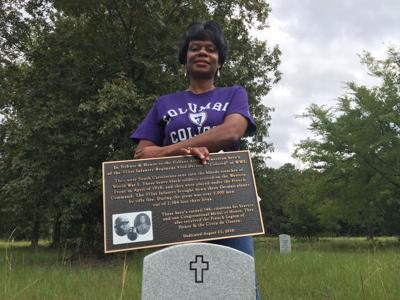
Sonya R. Hodges Grantham
For many years, Sonya R. Hodges Grantham has had a dual passion for two neglected chapters of Columbia’s African-American history.
One is the obscure Childs Cemetery, located along South Beltline Boulevard, near the former Intertape Polymer plant.
The other is the 371st Infantry Regiment 93rd Division (Colored) of World War I, which began in Richland County.
The land, which was the site of the former Wade Hampton plantation during the Civil War, is also where a number of 371st Infantry Regiment soldiers, such as Grantham’s own grandfather, would be laid to rest.
On Thursday, Sept. 28, the cemetery will be the location for a noon dedication of a historic marker honoring the fallen soldiers of the 371st Infantry Division.
“I’ve been the sole restorer, the preservationist and the researcher,” Grantham said on a recent tour of the cemetery, where sparsely plotted graves dot the grassy landscape.
Grantham — who has written her own self-published book, **Reclaiming Childs Cemetery** — has the history very much at her command.
Grantham says the land was purchased by the Childs family during Reconstruction.
“William G. Childs rode his horse here every Friday and he gave 50 cents to the elderly persons on the plantation,” she says. “They looked upon him as a Robinson Crusoe. Whatever they needed, he provided it for free.”
For many local descendants of slaves, the cemetery is a strong link to the past. For Grantham, the strongest link is WWI.
The 371st Infantry was organized just over a century ago, on Aug. 31, 1917, at Camp Jackson (which is now Fort Jackson). White officers were placed exclusively in charge of the all-black regiment.
Grantham says the Southern location proved an ideal training ground for soldiers.
“Look what we have here,” she says. “We had a lot of former plantations. We had the forest. We had the ditches. Ideal for training men.”
The 371st were sent to France in April of 1918, where a lot of the men would remain after the war.
“That’s how you got your black jazz nightclubs overseas in France,” she says.
For Grantham, the 371st Infantry has been largely overshadowed by the 369th Infantry Regiment, the legendary “Harlem Hellfighters.”
Yet soldiers from the 371st Infantry were honored with 146 citations for bravery. They also received the French Legion of Honor, the Croix de Guerre, and the only Congressional Medal of Honor ever awarded to an African-American soldier for WWI service.
The recipient was Corporal Freddie Stowers of Sandy Springs, South Carolina, who was 21 years old when his company led an attack at Champagne Marne Sector in France. German soldiers came out of the trenches in what looked like an attempt to surrender, when instead they resumed firing on American forces. Stowers was mortally wounded, but encouraged his men to keep going. They were eventually able to knock out a machine-gun nest and take German prisoners.
Although Stowers was nominated for the Congressional Medal of Honor, the award was held up for decades and was not resolved until 1991. Following a special investigation, the family of Corporal Stowers received the Congressional Medal of Honor in a special White House ceremony where President George H.W. Bush presented the honor to Stowers’ two sisters.
The former president will also be sending a letter for the Sept. 28 ceremony.
For Grantham, the idea of honoring these men at this particular place of rest started years ago.
“My mother would always tell me, ‘That cemetery is gone, so leave it alone, Sonya, stop asking about it.’”
But long after her mother passed away in 1999, Grantham has remained devoted to seeing to it that these men are not forgotten.
“The 371st is like the forgotten regiment,” she says.
The marker, paid for with private funds, aims to correct that.
“They were South Carolinians sent into the bloody trenches of World War I,” the marker reads. “These brave black soldiers arrived on the Western Front in April of 1918, and they were placed under the French Command. The 371st Infantry brought down three German planes by rifle fire. During the great war, over 1,000 men out of 2,384 lost their lives.”
UPDATE: There will also be an additional marker, identical to a marker in the Meuse-Argonne region, France, that will be dedicated at the Sept. 28 ceremony. This marker specifically honors the members of the 371st Infantry Regiment who lost their lives in the Sept. 28-Oct. 6, 1918, offensive in the Ardennes region of France. Despite heavy casualties, the regiment shot down three German airplanes, captured many prisoners, and claimed artillery weapons, a munitions depot, railroad cars, and enormous quantities of supplies. This marker will be provided by the Thompson/Grantham family.







